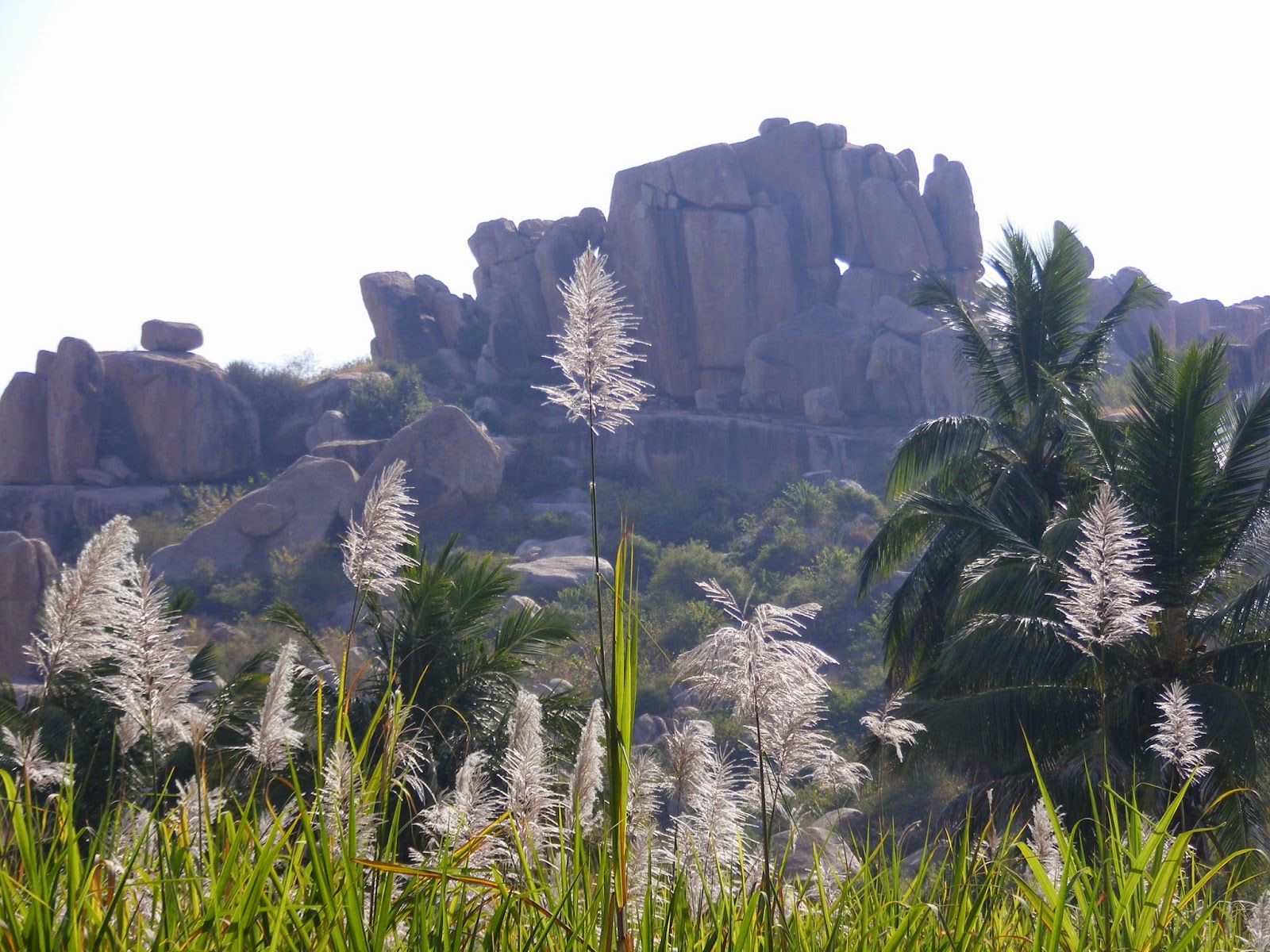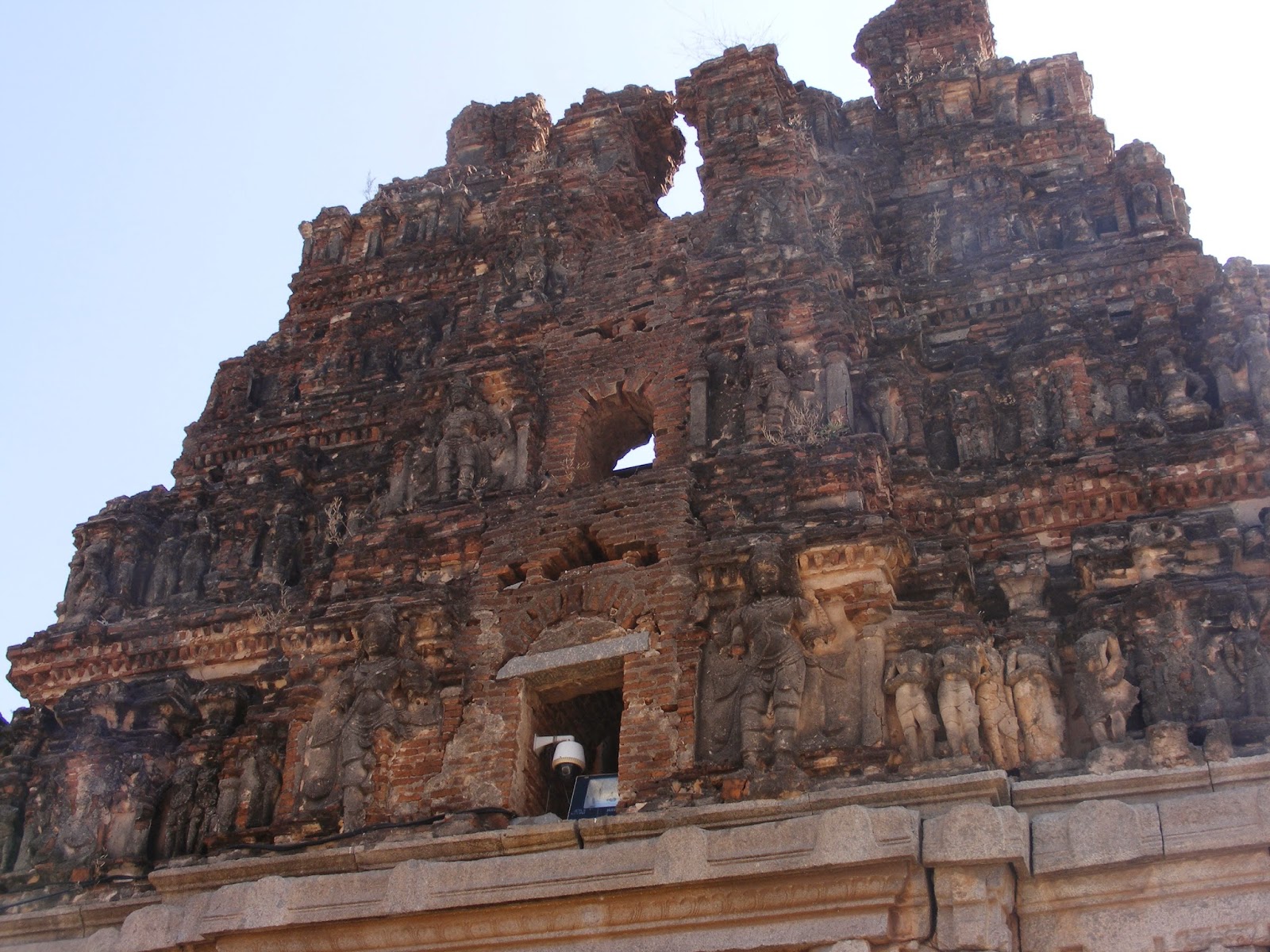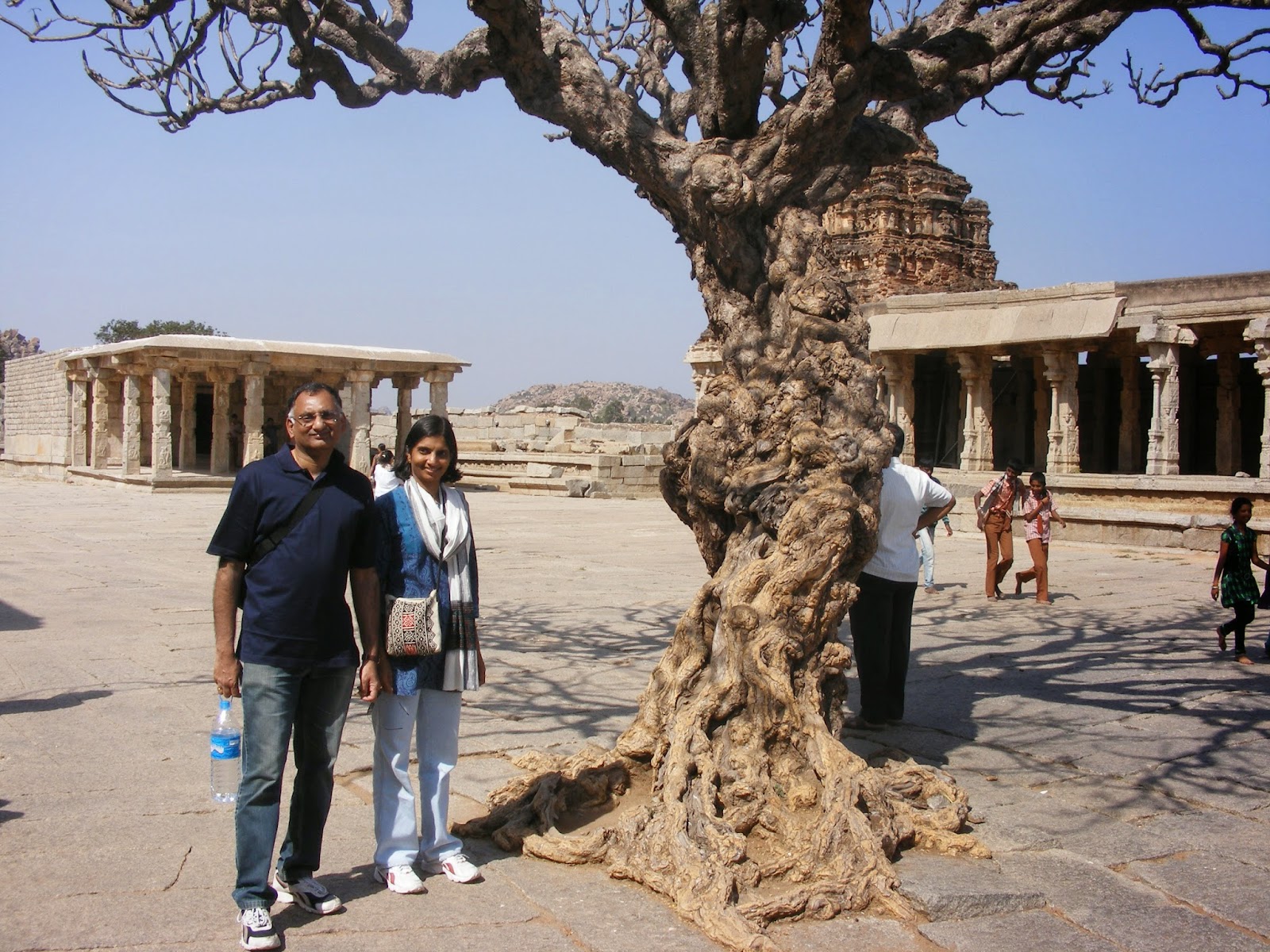The second day, we decided to start with the Vithala Temple, the oldest and biggest temple complex. It is truly a marvel.
So, the first thing to do was to take the ferry to the other side which proved to be a problem because it was Sankranthi day and there was a heavy rush. After waiting a long time, we did board the ferry. However, it was a trip I wouldn't wish to take again in my life for the dirt on the banks.
The only part that was interesting was a man doing yoga on the rock. Otherwise, the coracle ride was an adventure given that sitting in the coracle boat meant getting your bum wet and you can't stand ofcourse. No life jackets also and the Tungabhadra sometimes is not very kind.
Most of the boulders on the Tungabhadra has either a Lingam or a Nandi. I wonder many a time about the time when every rock and boulder was carved.
The first stop after crossing the river was to have breakfast. We found a small joint where paniyaram, mirchi bajji and idli was made at home. Tasty, simple food. The family managed their small outlet which was empty when we reached and brimmed with life just minutes after we ordered. I have always wondered what it is about our luck - no one in the shop and then, once we start looking at things, it is too much crowd. Kanaga enjoyed the food and tried out her Kannada.
Then started our tour. All around you will find boulders like this, beautiful, many a times providing scope for you to interpret them and keeping you amused. There will not be a moment when you will be bored by the landscape in Hampi. Nestled among the boulders you will find fields and orchards. It is as if people from a different age sculpted boulders and left them there to talk to a generation long afterwards.
Being Sankranthi day, we realized that entering the Virupaksha Temple will be a miracle. The crowd was so much that there was a sea of slippers at the entrance and there was no standing space. It is believed that a dip in the Tungabhadra and a visit to Virupaksha is a blessing on Sankranthi day.
The Vithala Temple was the one we decided to visit. The temple is not a living one ie. not in use anymore (there is no pooja offered for the diety). However, the complex spans acres and there is still excavation going on. The Vithala Temple was for my favourite, Krishna, an avatar of Lord Mahavishnu. No wonder it is beautiful and stands the test of time.
On the way to the main complex, one can see the foundations of pillars (in addition the ASI is trying to recreate also). So, the complex must have started somewhere near the gates and extended all the way in.
There are ruins of mandapams on the way also as well as the womens enclosures.
Many a times I wonder about the workmanship. The temple has stood for centuries and the work seen on the temples are just not made today. What we build today, we have to demolish in our lifetimes due to safety issues. Our forefathers built so many beautiful things for us to see and experience. What will we leave for generations to come.
The stone chariot in front of the temple is beautiful and given the time is remarkably well preserved.
The stone chariot is drawn by elephants. However, you can see that the elephants is a later addition - the original being horses.
Some parts of the temple were under renovation and therefore we could not go inside. However, the beauty seen from the outside as more than enough to keep us in awe.
I realized one thing. My dad during visits to the temples in Trichy said, that in those days, the best of granite was used and the craftsmen knew to pick the stones. Stones they say have a temperament and hence should be used accordingly. For example, some stones can be used to carve the feminine form while others the masculine. Similarly, certain stones cannot be used for carving as they are very hard and hence are suitable for structural strength. Similarly with wood. So says 'Thachu Sastra'. It must be true if architecture that is four centuries old still stands against harsh weather as well and multiple invasions.
When we finished the last part, we decided to have some groundnuts and corn sold in the place. The corn fields added the fine mix of nature and man.
The last part we visited - a probable watch tower giving a view of the entire area. We sat down and took in the view. I hope they preserve this structure just for the view it gives of the plains around.
So, the first thing to do was to take the ferry to the other side which proved to be a problem because it was Sankranthi day and there was a heavy rush. After waiting a long time, we did board the ferry. However, it was a trip I wouldn't wish to take again in my life for the dirt on the banks.
The only part that was interesting was a man doing yoga on the rock. Otherwise, the coracle ride was an adventure given that sitting in the coracle boat meant getting your bum wet and you can't stand ofcourse. No life jackets also and the Tungabhadra sometimes is not very kind.
Most of the boulders on the Tungabhadra has either a Lingam or a Nandi. I wonder many a time about the time when every rock and boulder was carved.
The first stop after crossing the river was to have breakfast. We found a small joint where paniyaram, mirchi bajji and idli was made at home. Tasty, simple food. The family managed their small outlet which was empty when we reached and brimmed with life just minutes after we ordered. I have always wondered what it is about our luck - no one in the shop and then, once we start looking at things, it is too much crowd. Kanaga enjoyed the food and tried out her Kannada.
Then started our tour. All around you will find boulders like this, beautiful, many a times providing scope for you to interpret them and keeping you amused. There will not be a moment when you will be bored by the landscape in Hampi. Nestled among the boulders you will find fields and orchards. It is as if people from a different age sculpted boulders and left them there to talk to a generation long afterwards.
Being Sankranthi day, we realized that entering the Virupaksha Temple will be a miracle. The crowd was so much that there was a sea of slippers at the entrance and there was no standing space. It is believed that a dip in the Tungabhadra and a visit to Virupaksha is a blessing on Sankranthi day.
The Vithala Temple was the one we decided to visit. The temple is not a living one ie. not in use anymore (there is no pooja offered for the diety). However, the complex spans acres and there is still excavation going on. The Vithala Temple was for my favourite, Krishna, an avatar of Lord Mahavishnu. No wonder it is beautiful and stands the test of time.
On the way to the main complex, one can see the foundations of pillars (in addition the ASI is trying to recreate also). So, the complex must have started somewhere near the gates and extended all the way in.
There are ruins of mandapams on the way also as well as the womens enclosures.
Many a times I wonder about the workmanship. The temple has stood for centuries and the work seen on the temples are just not made today. What we build today, we have to demolish in our lifetimes due to safety issues. Our forefathers built so many beautiful things for us to see and experience. What will we leave for generations to come.
The stone chariot in front of the temple is beautiful and given the time is remarkably well preserved.
The stone chariot is drawn by elephants. However, you can see that the elephants is a later addition - the original being horses.
Some parts of the temple were under renovation and therefore we could not go inside. However, the beauty seen from the outside as more than enough to keep us in awe.
I realized one thing. My dad during visits to the temples in Trichy said, that in those days, the best of granite was used and the craftsmen knew to pick the stones. Stones they say have a temperament and hence should be used accordingly. For example, some stones can be used to carve the feminine form while others the masculine. Similarly, certain stones cannot be used for carving as they are very hard and hence are suitable for structural strength. Similarly with wood. So says 'Thachu Sastra'. It must be true if architecture that is four centuries old still stands against harsh weather as well and multiple invasions.
When we finished the last part, we decided to have some groundnuts and corn sold in the place. The corn fields added the fine mix of nature and man.
The last part we visited - a probable watch tower giving a view of the entire area. We sat down and took in the view. I hope they preserve this structure just for the view it gives of the plains around.















































1 comment:
Hey got to read this today only. Would have joined u at the Orissa trip . Saw some really candid pics and got into nostalgic mood.We are near yet so far.
Post a Comment